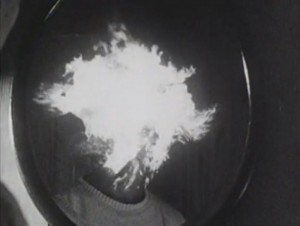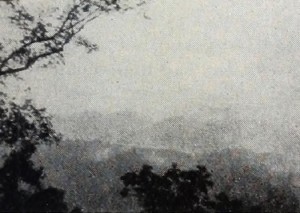"British cine amateur Donald S. James aided by Maureen Cottle has produced a tightly-knit comedy depicting three methods of capturing a burglar. In each episode, the same burglar enters the same home, but in each case, different methods are taken by the householders to effect his capture. The low key lighting is very effective and good editing has resulted in very professional results on the screen. Narration and sound effects on the recorded track round out the superior treatment of this better than average amateur effort." American Cinematographer, May. 1951, 192.
"Leo Caloia unlimbered his new Auricon sound camera to produce much of this picture and all of its sound track, but tighter editing as well as better direction would have greatly inproved the result. The continuity has to do with a couple, seen washing the supper dishes, discussing a proposed vacation, for which they have been putting money in a joint bank account. As they discuss the various places they would like to visit, there follow a number of scenes of each, then the camera cuts back to the discussion. The wife is summoned to the door by the mailman, receives a bill from a sporting goods store. She questions her husband about it and he confesses to having spent the proceeds of their bank account for a new set of golf clubs." American Cinematographer, May. 1951, 192.
"Lily Was A Lady: Roy C. Wilcox failed to state what camera he used in filming this fine study of the habits of Lily, a praying mantis, but both his color photography and his editing skill have netted a highly interesting film about one of nature's queerest insects." American Cinematographer, May. 1951, 192.
"My Sierra Hideway: Leon Paddock, using a Bolex H-16 camera and a variety of four lenses, has produced a fine pictorial account of the beauties of the High Sierra mountains in California. The sound, on magnetic tape, enhances the film's presentation which gets off to a fine start with excellent titles." American Cinematographer, May. 1951, 192.
"Nature Of Life: From far away Trieste, Giuseppe Della Noce sent this 550 foot black and white sound film, which represents tremedous effort, both in the photography and in the sound recording. Displaying the sensitive poetic talents of its maker, Nature Of Life is by way of revelation of life itself. The opening shots, conceived with great imagination, suggest the beggining of time, the settling of the earth and its eventual population. The mating instinct is portrayed in a childhood friendship that ripens into love and finally marriage, and the picture goes on from there to show the progression of life symbolized finally by an old couple slowly plodding up a mountain path, while two frisky youngsters pass them coming down the mountain. Unfortunately choice of narrator for the comentary was not the best and the narration, on which much of the picture's continuity and effectiveness depends, falls far short of its goal." American Cinematographer, May. 1951, 192.
"Of Kings And Queens: This Kodachrome entry endeavors to explain the game of chess to a little girl watching it being played by her father and a friend. Moving in close to the chess board, the camera shows in detail the various chess men and their relation to the game, as an off-stage voice explains this relationship to the girl. C. Richmond Lawrence employed his Bolex H-16 camera with great skill in photographing this film, and the narration on the sound track is of high calibre." American Cinematographer, May. 1951, 192.
"Reportaje Grafico Nacional: Alvaro Chavarria Nunez, who aspires to producing newsreels in his native Costa Rica, presents in this entry a typical effort. The picture is a newsreel of several national events held in this country, and while it displays aggresive camera work, the film result, a dupe print, suffers a great deal because of inferior laboratory work, and therefore the true quality of the photography could not be properly evaluated. Nunez recorded the sound track, using his Auricon film recorder." American Cinematographer, May. 1951, 192.

"The Mirror: This picture was described in considerable detail, as was the steps involved in its making, in our March issue. (See pg. 102.) Arthur H. Smith and Wolfgang Schubert photographed this mystery drama which is comparable in scope, if not quality, to the average feature film production. Unfortunately, inconsistent exposure and cast limitations detracted substantially from the otherwise overall good quality of the picture, but left with sufficient points to rate it an Honorable Mention award." American Cinematographer, May. 1951, 192.
"There Runs No River: Francis J. Barrett, who entered one of the top prize winning films in our 1950 competition, again displays his fine camera technique in this 8mm black-and-white narrative of contemporary life in drab surroundings. An excellent music and sound recording on tape enhances the presentation of this commendable amateur effort." American Cinematographer, May 1951, 192.

"If the lead title — Carolina Holiday — promises run-of-the-mill vacation footage, there is surely nothing else routine about this production. It is, rather, a rhapsody of color and a tone poem of contrasting moods, to which Henry K. Burns, jr., has brought fine technical skill and a perceptive eye for composition. Although rich in scenic beauty, his views are never static, for movement in a score of things — drifting fog, rustling leaves, an unexpected snow flurry — introduce animation unlooked for in the subject. An unfortunate commentary and hapless scoring (save toward the end) were detrimental to the film's achieving higher honors." Movie Makers, Dec. 1950, 466-467.
Total Pages: 299